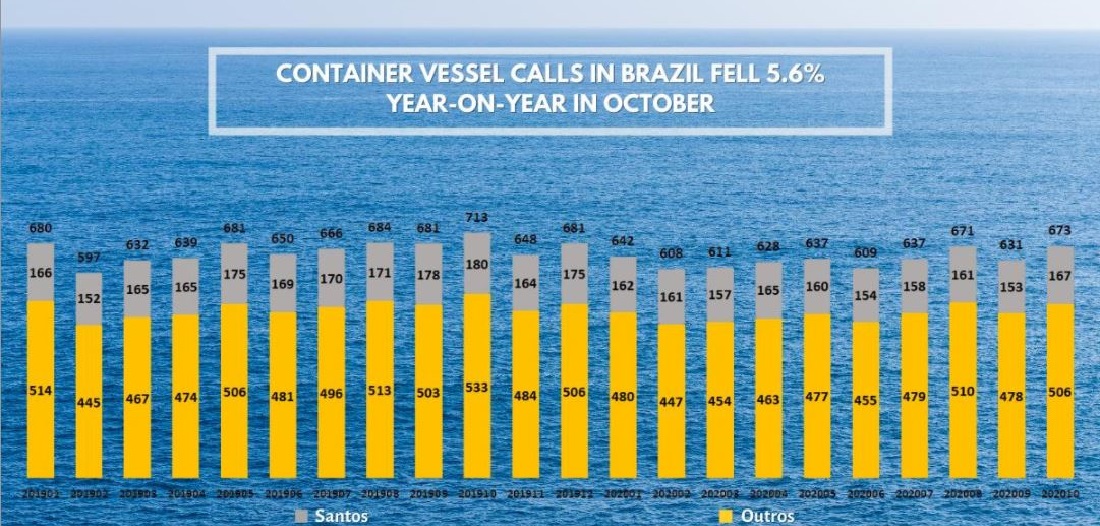
Container vessel calls at Brazilian ports fall 5.6% in October YoY
Nov, 04, 2020 Posted by Ruth HollardWeek 202046
In October, container vessel calls at Brazilian ports fell 5.6% in relation to the same month last year, reflecting the Coronavirus pandemic which reduced industrial activity, private consumption, and, consequently, imports via ports. In Santos, the drop was 7.2%. October was the busiest month in terms of port calls in 2019.
Despite this, in the comparison between September and October 2020, there was a 6.6% growth in ship calls. In Santos, growth was greater, at 9.15%, which shows a recovery. In the comparison between January and October 2019 and 2020, the results are still negative, with a 4.1% drop in the number of stopovers. In Santos, year-on-year, the fall was 5.5%.
Consult the chart below for a monthly history starting in January 2019::
Container ship calls | Jan 2019 to Oct 2020
Source: DataLiner
The following table shows the comparison of the ship calls by port from January to October 2019 and 2020:
Container ship calls in Brazilian ports – Jan to Oct 2019-2020
The growth in the Port of Itaqui is due to the fact that in August 2019, a testing phase occurred for a regular service that began in February / 2020.
Source: DataLiner (To request a DataLiner demo click here)
Regarding blank sailings, the forecast is for only one blank sailing this month from the owner PIL, in week 47, in the Asia trade (FEAS) – Sino South America service.
Port of Santos Performance
A report published on November 2nd by Folha de S. Paulo highlighted the fact that the agribusiness boom camouflaged the drop in the circulation of containers at the Port of Santos. Cargo-handling data at the site released by the port authority indicate that 2020 is a positive year, driven mainly by the movement of solid bulk cargoes, such as exports of sugar, corn, and soybeans.
ANTAQ (the national transport agency) believes that the drop observed in the handling of containerized cargo at the Port of Santos responds exclusively to cyclical factors, and not to long-term structural factors. In the entity’s assessment, the drop observed in the handling of containerized cargo is consistent with the adverse effects of the Covid-19 pandemic on the level of activity and private consumption, especially at the national level. The agency pointed out that the Port of Santos concentrates the largest industrial park and the largest consumer market in the country. “Let us remember that the Covid-19 outbreak in Brazil started in the state of São Paulo, which led the state government to immediately adopt strong restrictive measures on the circulation of people, on the functioning of trade and services, and requiring extra care in the functioning of industries,” ANTAQ stated.
This opinion is shared by Marcelo Ribeiro, Director of Santos Port Authority (SPA). “It is the situation when you look at the port data for export and import and you see that the port normally exports 70% and imports 30% of the cargo handled. But today it exporting 74% and importing 26% of cargo handled, and that it is the result of the conjuncture”, says Ribeiro.
SPA says the drop was expected and is consistent with the effects of the pandemic. At the same time, he understands that the first four months showed the resilience of the port in the midst of the pandemic, with a growth in exports.
The ports in the southern region of Brazil, on the other hand, benefited from the growth of animal protein exports, mainly to China, which continues to suffer from the African swine flu that decimated its pig herds, reduced the government’s protein reserves, and led the country to resort to imports to feed its population.
Information from Folha de S. Paulo
-
Other Cargo
Apr, 12, 2024
0
Brazilian Footwear Industry Grapples with Export Decline Amid Surging Asian Imports
-
Other Cargo
Feb, 25, 2022
0
Brazil becomes the world’s second largest exporter of black pepper
-
Steel and Aluminium
Jul, 15, 2021
0
EU carbon tax could affect Brazilian steel
-
Ports and Terminals
Feb, 17, 2023
0
Users criticize new screening yard charge at the Port of Salvador



